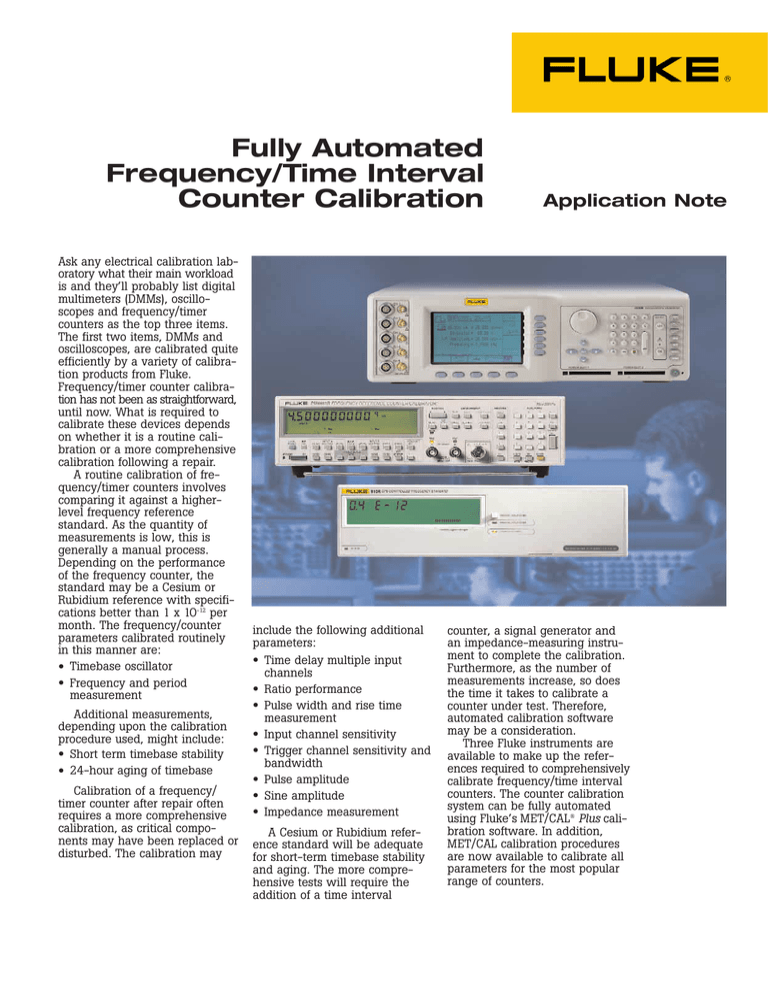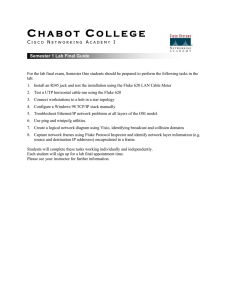
Fully Automated
Frequency/Time Interval
Counter Calibration
Ask any electrical calibration laboratory what their main workload
is and they’ll probably list digital
multimeters (DMMs), oscilloscopes and frequency/timer
counters as the top three items.
The first two items, DMMs and
oscilloscopes, are calibrated quite
efficiently by a variety of calibration products from Fluke.
Frequency/timer counter calibration has not been as straightforward,
until now. What is required to
calibrate these devices depends
on whether it is a routine calibration or a more comprehensive
calibration following a repair.
A routine calibration of frequency/timer counters involves
comparing it against a higherlevel frequency reference
standard. As the quantity of
measurements is low, this is
generally a manual process.
Depending on the performance
of the frequency counter, the
standard may be a Cesium or
Rubidium reference with specifications better than 1 x 10-12 per
month. The frequency/counter
parameters calibrated routinely
in this manner are:
• Timebase oscillator
• Frequency and period
measurement
Additional measurements,
depending upon the calibration
procedure used, might include:
• Short term timebase stability
• 24-hour aging of timebase
Calibration of a frequency/
timer counter after repair often
requires a more comprehensive
calibration, as critical components may have been replaced or
disturbed. The calibration may
include the following additional
parameters:
• Time delay multiple input
channels
• Ratio performance
• Pulse width and rise time
measurement
• Input channel sensitivity
• Trigger channel sensitivity and
bandwidth
• Pulse amplitude
• Sine amplitude
• Impedance measurement
A Cesium or Rubidium reference standard will be adequate
for short-term timebase stability
and aging. The more comprehensive tests will require the
addition of a time interval
Application Note
counter, a signal generator and
an impedance-measuring instrument to complete the calibration.
Furthermore, as the number of
measurements increase, so does
the time it takes to calibrate a
counter under test. Therefore,
automated calibration software
may be a consideration.
Three Fluke instruments are
available to make up the references required to comprehensively
calibrate frequency/time interval
counters. The counter calibration
system can be fully automated
using Fluke’s MET/CAL® Plus calibration software. In addition,
MET/CAL calibration procedures
are now available to calibrate all
parameters for the most popular
range of counters.
A basic counter calibration
system to perform routine calibration includes a 910R
GPS-Disciplined Rubidium
Reference Standard, a PM 6681
Timer/Counter/Analyzer and
MET/CAL Plus software.
A more comprehensive system
requires the equipment above in
addition to a source of signals
that is traceable and covers the
dynamic range of the counter
workload. For this exercise, Fluke
added the 9500B Oscilloscope
Calibrator.
External
Reference In
3 x 10 MHz Out
910R
External
Reference In
CH1
CH2
CH3
PM6681
9500B
A
Interior
Reference Out
External
Reference In
UUT
= Feed Through
Termination
Why use an oscilloscope
calibrator?
The Fluke 9500B Oscilloscope
Calibrator can deliver a multitude
of signals, including leveled sine
to 6 GHz. The 9500B is basically
a comprehensive signal source
with traceability that was
designed specifically to support
oscilloscope calibration. However,
the 9500B’s comprehensive feature set, when accompanied by
the Fluke 910R and PM 6681
counter, extends the workload of
the 9500B to cover the most
popular frequency/time interval
counters, even after repair.
9500B features for use with
frequency counter calibration:
• Additional channels to support
multi-channel counters
• Ability to measure counter
input impedance
• Adjustable pulse delay
between output channels for
counter inter-channel delay
tests
• Adjustable and traceable leveled sine to 6 GHz for channel
amplitude calibration, and trigger sensitivity
External
frequency reference
•
lock input to improve timebase
accuracy
• Switched 50 Ohm/1 MOhm
termination
Counter calibration system
Figure 1 details a typical configuration of a counter calibration
system using Fluke instruments.
Interconnection between products is established using suitable
BNC cables in series with a
50 Ohm terminator for impedance matching between the
counter, frequency standard, and
Figure 1. Typical configuration of a counter calibration system, using Fluke instruments.
the unit under test. Note: the
9500B does not require external
terminators as its 50 Ohm/1 MOhm
termination is switched internally.
To help improve throughput, it
is possible to connect the output
of the 9500B to all input and
trigger channels on the counter
under test simultaneously. This
will, however, depend on the
number of 9500B Active Heads
available.
System Accuracy
Specification based on a
GPS locked 910R)
Timebase
Channel Delay
Sine Amplitude
Flatness to
3.2 GHz
1 x 10 -12
±5 ps ch to ch
5%
Automation using
MET/CAL® Plus calibration
software
Function Select Codes (FSCs) for
the referenced products described
in Figure 1 are available within
Fluke’s MET/CAL Plus calibration
software. Calibrating counters
automatically also requires the
appropriate UUT software calibration procedures. Example
MET/CAL procedures are available
from Fluke to cover the most
popular counter/timers, including
the PM 6680 and the Agilent
53131A.
Typically, counters supplied
from the same manufacturer
have similar test parameters;
therefore a generic calibration
procedure could be considered
for each counter series. A 29page document entitled “Generic
Frequency/Timer Counter
Calibration Procedure” provides
details about calibration system
configuration, required stimulus
and calibration test-points for
both the PM 6680 and Agilent
53131A Frequency Counters. This
document is available for download from the Fluke web site,
www.fluke.com. Just go to the
Calibrators product section and
click on the “Application Notes”
navigation button.
You can also find useful application notes by going through
the product pages for Timer/
Counters on the Fluke web site.
Fluke. Keeping your world
up and running.
Fluke Corporation
PO Box 9090, Everett, WA USA 98206
Fluke Europe B.V.
PO Box 1186, 5602 BD
Eindhoven, The Netherlands
For more information call:
In the U.S.A. (800) 443-5853 or
Fax (425) 446-5116
In Europe/M-East/Africa (31 40) 2 675 200 or
Fax (31 40) 2 675 222
Canada (800)-36-FLUKE or
Fax (905) 890-6866
Other countries +1 (425) 446-5500 or
Fax +1 (425) 446-5116
Web access: http://www.fluke.com
©2002 Fluke Corporation. All rights reserved.
MET/CAL is a registered trademark of Fluke Corporation.
03/2002 1677249 A-ENG-N Rev A
Printed on recycled paper.



